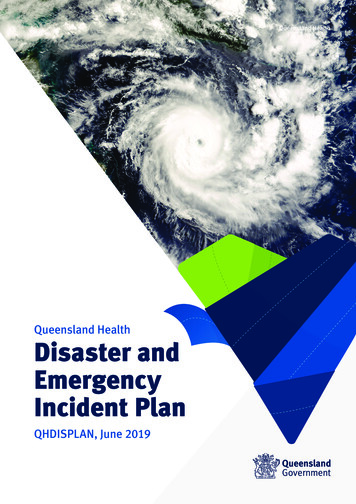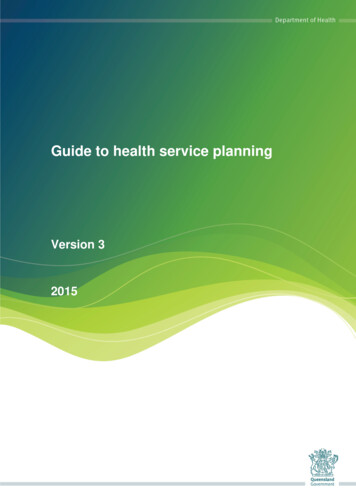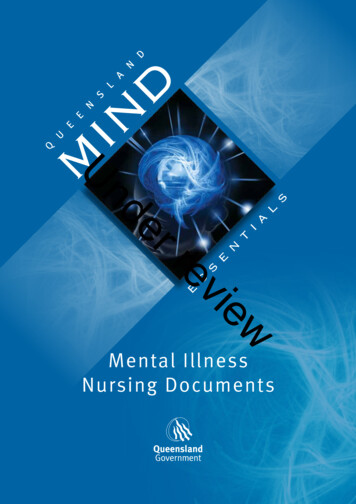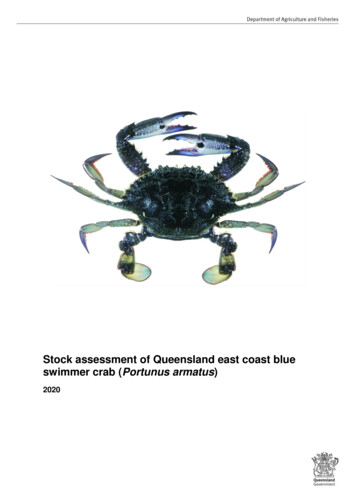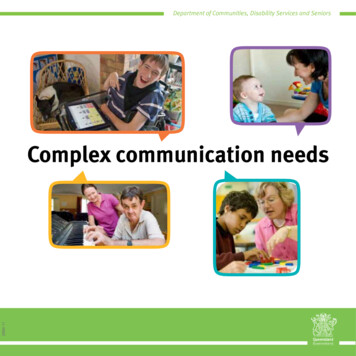
Transcription
Department of Communities, Disability Services and Seniors2884-11Complex communication needs
AcknowledgmentsThe original version of this booklet was developed with contributions from the staff andstudents of The University of Queensland. Particular thanks go to Carole-Ann Grieg, TanyaHirst, Laura Parkhill, Sarah Sinnamon, Anna Walker and Shaun Ziegenfusz.Third Edition, October 2018 The State of Queensland (Department of Communities, Disability Services and Seniors) 2018. Copyright protectsthis publication. Excerpts may be reproduced with acknowledgment to the State of Queensland (Department ofCommunities, Disability Services and Seniors).Department of Communities, Disability Services and SeniorsGPO Box 806Brisbane Q 4001www.disability.qld.gov.au2
ContentsCommunication and why it is important2How we communicate3Who may have complex communication needs?4What is it like to have complex communication needs?6The role of communication partners7Strategies for communication partners8What is a communication-friendly environment?11Supporting effective communication12Communication breakdown15Australian professional guidelines on AAC16References18For further information191
Communication and why it is importantCommunication is the act of giving or receiving information.Communication is: fundamental to all aspects of life important for quality of life a foundation for learning a human right (United Nations Convention on the Rights ofPersons with Disabilities 2006).Effective communication enables people to:2 express their thoughts, opinions and personality ask for and receive information build relationships make decisions express and meet their basic needs refuse or reject make requests and suggestions about services they receive take part in social activities be heard and understood participate in their community.A person’sability tocommunicateeffectively mayhave an impacton his or herability to buildrelationships,make choicesand participate ineveryday life
How we communicateEveryone uses a variety of methods for communication,which can include: speech actions writing facial expression touch miming eye gaze behaviour tone of voice vocalisations body language gestures. signingPeople may use any number of these methods, in any combination.Both action (response) and inaction (lack of response) conveyinformation or messages.All forms of communication are equally valid.Important principles for supporting people with disability and complex communication needs include: the right to: express their feelings, needs and wants in a way that others can understandand respond to understand the communication of others support to develop an effective, efficient, reliable and independent means of communication support through a range of communication methods access to an effective means of independent communication, which provides a safeguard for peoplewith disability and complex communication needs.3
Who may have complex communication needs?People who have complex communication needs may not have thecommunication skills to meet all of their needs. For some people this istemporary, while for others it is ongoing.Some people may not havespeech and will rely on othermethods of communication,such as pointing or gestures.Some people may usespeech but it may be difficultto understand.Some people may be able tocommunicate but havedifficulties understandingwhat other people say.4
Peoplewith complexcommunicationneeds can beof any age, ofany cultureand from anysocioeconomicbackgroundComplex communication needs may be associated with developmentalor acquired disabilities.Developmental disabilities are present at birth or occur before the ageof 18, and may affect social or cognitive development.Some examples of developmental disabilities are: intellectual disability Down syndrome cerebral palsy autism.Acquired disabilities occur as a result of illness or injury.Some examples of acquired disabilities are: traumatic brain injury multiple sclerosis stroke.5
What is it like to have complex communicationneeds?It can be difficult to appreciate what it is like to be unable tocommunicate using speech or through writing. The following quoteprovides some insight.If you want to know what it is like to be unable to speak, thereis a way. Go to a party and don’t talk. Here is what you willfind: people talking; talking behind, beside, around, over, under,through and even for you. But never with you. You are ignored.Rick Creech in Beukelman & Mirenda 2005Communication is part of daily life and cannot be considered separatelyfrom other activities. Having an effective communication systeminfluences the success of our personal interactions, our involvementin activities, and our ability to make decisions. These can range fromeveryday decisions, such as which shirt to wear, to life-changingdecisions, such as where to live.6
The role of communication partnersA communication partner is anyone who talks or interacts with anotherperson. We are all communication partners.It is important for communication partners to support people withcomplex communication needs to identify and use the communicationmethods that work best for them and enable their own imisesparticipationand minimiseslimitationsCommunication partners of people with complex communication needsshould be aware of the following: Communication is a constant experience. For people with complex communication needs, not havingaccess to an effective communication system can be frustrating.This frustration sometimes results in behaviours of concern. The way we communicate with people with complexcommunication needs influences how they are perceived byothers and how they perceive themselves. People with complex communication needs are more vulnerableto abuse, assault and neglect than others, as they are less ableto report incidents. The ability to communicate is an importantmechanism for reducing the risk of abuse, assault or neglect. Communication enables people to express their personality, humour,interests and dislikes.7
Strategies for communication partnersIt is important to respect and understand that common barriers maycause people with complex communication needs to have difficulty orbe unable to demonstrate their communication skills.To be an effective communication partner for someone with complexcommunication needs you should consider having: competent communication partnerscommunication-friendly environmentsessential communication tools and resources.Identify the methods the person uses to communicate These may include speech, signs or gestures, or usingpictures, facial expressions, or a communication device. Use the person’s effective communication methods appropriate to theenvironment—for example, sign as you speak or point to objects inthe environment.Demonstrate respect and remember: to use respectful and age-appropriate communication that a person’s expressive skills may not represent their ability.Gain and maintain attention8 Use the person’s name. Use facial expressions, tone of voice and humour to add informationand interest.Friends,family or carerswho knowthe personwell will havesuggestionson how youcan assist theperson to betterunderstandyou and tocommunicateeffectively withyou
Talk about things that are interesting and relevant to the hereand now Talk about the current activity. Explain what you are doing as you do it. Create or use a chat book with photos and captions to help otherslearn about the person’s interests and prompt interaction. Give specific examples. Communicate for a variety of reasons—for example, makeobservations, share opinions, tell jokes.Cue the person with complex communication needs to initiatea response Give expectant pauses. Provide verbal cues or physical prompts.Offer choices Provide real opportunities for choice within activities, such aswhat to wear, eat or do. Provide visual representation of choice—for example, showcereal packets when discussing breakfast options.To be able to make an informed choice, people need to experienceand know what the alternatives are. The alternatives need to bepresented in a way meaningful to them. Choice may sometimes beindicated by things such as: participation or non-participation picking up the chosen object looking or pointing at the desired item vocalising.9
Keep sentences short Chunk information together. Be specific. Talk about one step at a time.Support the person with complex communication needs to develophis or her communication skills across a range of environmentsand with different people Identify opportunities for communication to take place—think aboutthe person’s interests, activities and routines. Acknowledge all communication attempts. Develop and use ‘about me’ books and communication passports toshare this information between communication partners.Listen attentively10 Use eye contact. Use gestures such as nodding your head. Rephrase what is being said. Be aware of your non-verbal communication. Try not to talk too much. Wait for the person to finish.It isimportant that allcommunicationpartners havea sharedunderstandingof how someonecommunicates
What is a communication-friendly environment?A communication-friendly environment is one that provides opportunitiesfor communicating about a range of topics, has communication partnersthat can support different ways of communicating and has a range of toolsavailable to support communication success.Communication partners can contribute to communication-friendlyenvironments in the following ways.Minimise distractions. Consider background noise, such as TV, radio, fans and air conditioning. Avoid crowded or busy places. Move to a quieter location. Consider lighting. Have communication aids nearby—prepare materials in advance that willsupport communication in specific activities.Ensure the person is comfortable. Check the person’s positioning. Consider whether equipment is required such as a more comfortable chairor a table to put communication aids on.Place yourself at eye level. Face the person and use eye contact. Gain their attention. Position yourself at the same level as the person.Consider involving other communication partners. Is there someone else who might be interested in joining the conversation? What are the person’s communication needs and methods? Bring people together through shared activities or interests.Avoid talking about the person in front of him or her.11
Supporting effective communicationThe use of objects, photographs, pictures and symbols can supportpeople to understand information they are given and to expressthemselves to others more effectively.Supporting understandingSpoken language is fleeting—some people may miss information andnot be able to follow the conversation. Using tools to aid understandingcan be very effective.For example, holding an object or pointing to a picture when you aretalking reinforces the spoken message and increases the likelihood thatyour communication partner will understand.Objects and pictures are present for longer than the spoken word. Theycan be understood more easily because they represent somethingtangible.Where a person has difficulty understanding too many things at once,only introduce one concept or piece of information at a time. When yougive instructions, use short steps and introduce only one or two steps ata time.12
Tools can also be used to: jog the memory—for example, avisual calendar used as a pictorialreminder of activities for theweek ahead assist a person to know what is expected of them—for example, holding up a set of keys to indicate that it is time togo for a drive help organise thinking—for example, an illustrated recipewith photos of the sequentialsteps to be taken to completethe task enable someone to feel in control and less anxious—for example,a daily schedule with photographs of people who are likely to bevisiting.13
Supporting expressionPeople who do not use speech or whose speech may be difficult tounderstand can use tools to assist their communication partners tounderstand their ideas, thoughts and feelings.The use of tools can help a person with complex communication needs to:14 clarify and provide information—for example, pointing to varioussymbols to clarify the topic he orshe wishes to talk about ask for something—for example,holding up a towel and gogglesto indicate he or she wants to goswimming express his or her feelings—for example, pointing to the word‘excited’ from a list of emotion words.
Communication breakdownCommunication breakdown occurs when a message is not conveyedsuccessfully from one communication partner to another.If someone you are communicating with does not understand you: repeat or rephrase the information reduce the amount of information in the message use visual supports seek help from communication partners who know the person well.If you do not understand someone you are communicating with: let the person know that you have not understood—do not pretendyou understand ask the person to show you what he or she means ask the person to say it in a different way check if the person’s non-verbal communication supports his or hermessage.To avoid communication breakdown, support your message by usingvisual aids such as pictures and objects in the environment. You can alsodemonstrate or use actions and pointing to enhance the message.You can also help by: using clear, simple language and avoiding the use of slang slowing down and shortening the message saying the message in a different way.Continue to develop your knowledge of the way a person communicates.Record successful strategies and share observations with othercommunication partners.15
Australian professional guidelines on AACSpeech Pathology Australia (SPA) is the national peak body forthe speech pathology profession in Australia.SPA develops clinical guidelines that incorporate research toidentify evidence-based approaches and practices. Theseguidelines are an important guide for best practice in supportingpeople with complex communication needs.SPA revised its clinical guideline on Augmentative and AlternativeCommunication (AAC) in 2012. While the clinical guideline hasbeen written for speech language pathologists, it may also bereferenced by managers and consumers.Some key elements of the Augmentative and AlternativeCommunication Clinical Guideline are: the need for speech pathologists to work collaboratively as partof a team using a person-centred approach when supportingpeople with complex communication needs that communication supports are informed by evidence-basedpractice that all people with disability and complex communicationneeds are comprehensively assessed for their use ofaugmentative and alternative communication that people with complex communication needs should beprovided with a range of communication systems andstrategies to support them to meet their varied communicationneeds.SPA also provides specific guidance in relation to a method calledfacilitated communication (also referred to as ‘supported typing’ or‘assisted typing’, or ‘rapid prompting’). In these clinical guidelinesSPA concludes that, after evaluating the research evidence base,facilitated communication remains an approach with littlesupportive evidence and a preponderance of evidence thatcontraindicates its use, and its use is not recommended.16
If facilitated communication is raised with them, speechpathologists have an ethical responsibility to inform their clientsand families of the lack of supportive evidence and evidence ofknown harms associated with facilitated communication in theliterature, including the harms of subconscious facilitator influenceand false allegations of sexual abuse.Furthermore, speech pathologists supporting people who usefacilitated communication cannot assume that messagescommunicated by facilitated communication are the person’s ownmessages. Speech pathologists have an ethical responsibility to:(a) assess whether the communication is the person’s owncommunication or has been influenced by the facilitator; and (b)explore all Augmentative and Alternative Communication systemaccess methods (including direct and indirect access) andstrategies that allow the person to communicate independently (p.29-30).To find out more about SPA and download a copy of the AACclinical guideline, visit Speech Pathology Australia.17
References18 Beukelman, D and Mirenda, P 2013, Augmentative and alternative communication:supporting children and adults with complex communication needs, 4th edn, Paul H.Brookes Publishing Co, Baltimore, Maryland. Speech Pathology Australia 2012, Augmentative and Alternative CommunicationClinical Guideline, Speech Pathology Australia, Melbourne. United Nations General Assembly 2006, Convention on the Rights of Persons withDisabilities.
For further informationPhone 1300 QGOV (13 74 68)*Telephone Typewriter (TTY) 13 36 77Email disabilityinfo@communities.qld.gov.auWebsite Department of Communities, Disability Services and SeniorsNational Relay Service Speak & Listen 1300 555 727National Relay Service SMS Relay 0423 677 767Speech Pathology Australia 1300 368 835Translating and Interpreting Service 13 14 50(Ask to be connected to the Disability Information Service.)This document is available in alternative formats (including large print)on request. If you would like a copy in another format, please phone13 QGOV (13 74 68)* or email disabilityinfo@communities.qld.gov.au* Cost of a local call. Calls from mobile phones are charged at applicable rates.
complex communication needs to identify and use the communication methods that work best for them and enable their own independent communication. Communication partners of people with complex communication needs should be aware of the following: Communication is a constant experience. For people with



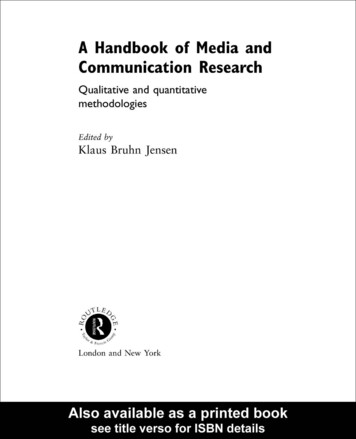
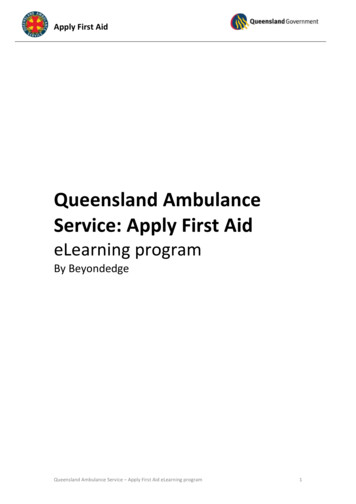
![Clinical Biostatistics [CLB]](/img/6/study-guide-clb-2021.jpg)

